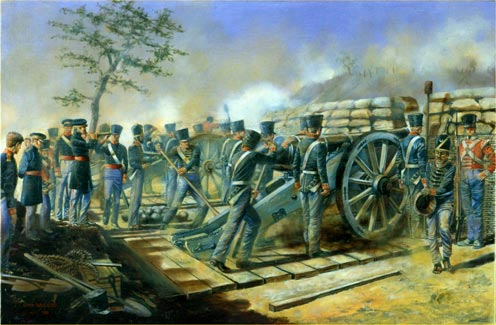
"The Bengal Artillery at the Siege of Bhurtpore, 1825-26"
Ref: DR016
by David Rowlands
Image Size: 58 x 38 cm
Bhurtpore, about a hundred miles South of Delhi, was a fortified city perched on a great mound. The walls of the fortress were built of mud, of immense thickness, and the round shot fired by artillery in those days simply buried themselves deeply in their sides. Following the murder of the rightful successor to the ruler of Bhurtpore, lawlessness and oppression prevailed in the region. The Governor General ordered the Bengal Army to restore order there.
One cavalry and two infantry divisions, with a powerful siege train of the Bengal Army marched towards the city. Then began the slow, methodical work of digging the parallels, emplacing the guns behind defensive parapets and bringing up and defending the massive quantity of ammunition that was required. In the rocky soil around Bhurtpore every European and Native soldier was employed in the hard work of digging these positions.
The guns steadily pushed forward as new parallels were dug, until the breaching batteries were established no more than 250 yards from the fortress. On 18th January 1826 the final assault was made, and Bhurtpore was captured.
Gabions filled with earth protect the guns from enemy fire. Above these are laid fascines and sandbags. Bhurtpore's crumbling walls of dry mud, which the artillery has been bombarding night and day, can be glimpsed above the gun position. I have depicted an iron 24-pounder gun on its wooden platform. The piece of the gun would have been horizontal at this range. The NCO in charge of the gun is sighting it by looking along the piece. Two men with hand-spikes manhandle the bracket trail according to his instructions. This would have to be done each time the gun was fired. The solid round shot has been loaded and rammed home on its wooden sabot. After correctly laying the gun, the NCO will retire to the left rear and order the man holding the portfire to ignite the charge. A native lascar or 'Golundauze' is replenishing the water bucket for the spongeman. In the background a bugler of the Bengal Artillery can be glimpsed in his red jacket. At far right is a soldier of HM's 59th Foot, which served in the trenches and took part in the assault.
In 1861 the Bengal Artillery was absorbed into the Royal Artillery.
